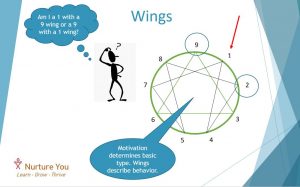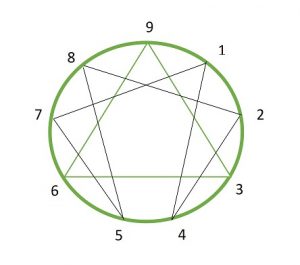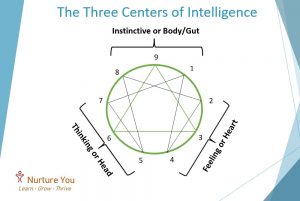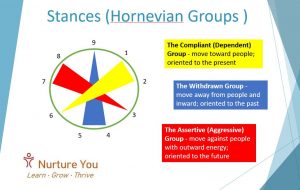Highlights
- Merriam-Webster defines “enneagram” as a regular geometric figure with nine points.
- There are hundreds of Enneagram teachers today, not all of which are grounded in the spiritual tradition of the Enneagram. Take care to know the source where you turn for Enneagram instruction.
- Well regarded contemporary theorists and developers of the field include David Daniels, Don Riso and Russ Hudson, Jerry Wagner, Mark Bodnarczuk, Richard Rohr, Sandra Maitri, Beatrice Chestnut, and Ginger Lapid-Bogda.
- They do not all agree with each other, nor do they all use the same terms. Stay open and use what works for you. If something doesn’t fit or feel right, put it on the shelf. You can leave it there forever, but you may just want to go back to it later.
- The Enneagram is complex and dynamic. Our understanding of it continues to evolve. People work with it for 25 years and say they still feel like novices. Let this excite rather than overwhelm you.
The Nine Enneatypes
The foundation of the Enneagram is the 9 types or styles or Enneatypes. The numbers are neutral. Enneagram teachers say:

– We all have access to all 9 types. The better we understand them, the easier it is to use them.
– Our type is based on a combination of genetics and environment.
– In an effort to succeed in the environment we encountered as a young child, each of us adopted a style, a way of viewing the world, a set of behaviors.
– Everyone has a basic type, and it does not change over time. The description of each type applies universally to males and females.
– The Enneagram does not put us in a box; it shows us the box we’re already in and how to get out of it.
– The best way to determine your type is NOT with a test. It’s by learning about each type and observing yourself. Not every aspect of the description will fit you.
– There are no good or bad types. Riso and Hudson describe Levels of Development, a continuum of behaviors for each type ranging from unhealth to healthy. Each type has it capacities and limitations.
Wings
The types on either side of our basic type are called “wings,” styles you adopt as secondary to your basic type. Some teachers give these greater importance than others.

– When determining your type, it’s more important to consider why you do what you do, your motivations, rather than what you do, your behavior.
– Wings are determined by looking at behaviors.
– Susan Stabile teaches that we have one wing for the first half of our life and add the other wing during the second half.
Dynamic Points

– As seen in the Enneagram diagram, each type is connected internally to two other points.
– Although we have access to all nine types, the
styles of these connecting points are more natural for us, so it’s helpful to
be familiar with your dynamic points.
Centers of Intelligence
The 9 types are grouped into many triads. The most prominent triad is the three Centers of Intelligence:

– Instinctive or Body/Gut (doing) – Types 8, 9, 1: they take in information initially through the body, having a physical sensation, and strive to control their environment. Their underlying passion is anger.
– Feeling or Heart (fixing) – Types 2, 3, 4: these types are concerned with self-image and are overwhelmed by their own and others’ feelings. Their passion is shame.
– Thinking or Head (understanding) – Types 5, 6, 7: these folks look to strategies and beliefs to find a sense of inner guidance and support. Their underlying passion is fear.
The Stances
Another helpful triad to know about is the Hornevian Groups, also known as stances, which describe the basic posture of each type and how they move in the world:

– The Compliant (Dependent) Group – types 1, 2, and 6; move toward people; committed, hard workers, sacrificial, and responsible; orientation to time is present
– The Withdrawn Group – types 4, 5, and 9; move away from people and inward; does not mean introverted; introspective, imaginative, and not attention seeking; orientation to time is past
– The Assertive (Aggressive) Group – types 3, 7, and 8; move against people with outward energy; independent, energetic, and assertive; orientation to time is future
The Instincts or Sub-Types

More advanced Enneagram teaching addresses the Three Instincts or Sub-types. By definition, instincts are present at birth, shared by all members of the species, and represent a tendency to respond a certain way to the environment without reasoning. The three Enneagram instincts listed below create 27 possible combinations of styles.
– Self-preservation: tendency toward nesting and nurturing
– Social or Navigating: preference for orientating to a group
– Sexual or Transmitting: inclination for attracting and bonding